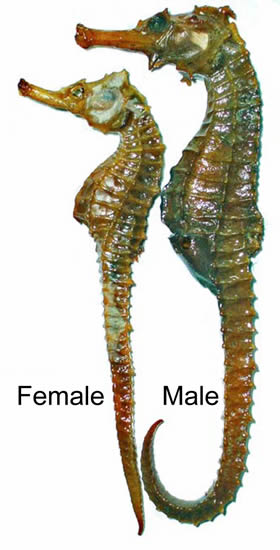Sad Seahorse, Hippocampus tristis Castelnau 1872

A Sad Seahorse, Hippocampus tristis. Source: Rudie Kuiter / Aquatic Photographics. License: All rights reserved
A drab grey to pale brown seahorse, sometimes with tiny white spots in longitudinal lines on the body. Juveniles are occasionally pale yellow, and may have prominent saddle-like blotches. The Sad Seahorse is only known from specimens trawled specimens off southern Queensland, northern New South Wales, and Lord Howe Island. Juveniles are very spiny.
Sad Seahorse, Hippocampus tristis Castelnau 1872
More Info
|
Distribution |
Endemic to subtropical waters of eastern Australia, from off southern Queensland to off Iluka, northern New South Wales, and off Adelaide, South Australia; also Lord Howe Island in the Tasman Sea. Trawled in depths of 18-62 m. |
|
Features |
Dorsal fin 18-19; Anal fin 4; Pectoral fin 18-19; trunk rings 11; tail rings 35-37; subdorsal rings 2 + 1-2. |
|
Size |
Height to 230 mm. |
|
Colour |
In life, drab grey to pale brown, head and trunk dusky, sometimes with numerous tiny white spots in longitudinal lines; juveniles occasionally pale yellow; large juveniles occasionally with prominent saddle-like blotches, contrasting with general colour, at 1st, 4th and 8th trunk rings, and along tail. In preservative - cream to pale brown, with some dark spotting near eyes. |
|
Feeding |
Like most other seahorses, this species presumably feeds by sucking small prey items such as crustaceans and zooplankton into its mouth. |
|
Biology |
Sexes separate; males give birth to tiny independent young. The female uses an ovipositor to transfer her eggs into an elaborate enclosed pouch under the abdomen of the male. The male not only fertilizes the eggs inside the pouch and provides physical protection for the developing embryos, he also osmoregulates and aerates the embryos and may provide some nourishment until the offfspring are born. |
|
Fisheries |
None. Although taken in commercial trawls, there is no known trade in this species for the aquarium or Asian Traditional Medicine industries. |
|
Conservation |
International: Listed under Appendix II of the Convention on the International Trade in Endangered Species of Wild Flora and Fauna (CITES). As a result, the species is subject to the Convention, http://www.cites.org/. |
|
Remarks |
Some authors consider H. tristis to be a synonym of H. kelloggi, a larger species not found in Australian waters. |
|
Similar Species |
H. tristis is most similar to H. taeniopterus, differing primarily in having a double lowermost shoulder-ring spine and a more distinct and more erect coronet. H. tristis has been misidentified as H. whitei, H. kuda and H. kelloggi. It is readily distinguished from H. whitei by the smaller coronet and position of the uppermost shoulder-ring spine, at the gill opening in H. tristis and near the pectoral-fin base in H. whitei. H. kuda and H. kelloggi are not found in Australian waters. |
|
Etymology |
From the Greek ippos = horse and kampe = curvature. The specific name tristis is Latin for sad, in reference to the spotting around the eyes which resemble tears. |
|
Species Citation |
Hippocampus tristis Castelnau 1872, Proc. Zool. Acclim. Soc. Vict. 1: 197, Melbourne markets. |
|
Author |
Bray, D.J. 2019 |
|
Resources |
Sad Seahorse, Hippocampus tristis Castelnau 1872
References
Castelnau, F.L. 1872. Contribution to the ichthyology of Australia. No. 1. The Melbourne fish market. Proc. Zool. Acclim. Soc. Victoria 1: 29-242.
Dawson, C.E. 1994. Family Syngnathidae. pp. 440-475 figs 391-426 in Gomon, M.F., Glover, C.J.M. & Kuiter, R.H. (eds). The Fishes of Australia's South Coast. Adelaide : State Printer 992 pp. 810 figs.
Johnson, J.W. 2010. Fishes of the Moreton Bay Marine Park and adjacent continental shelf waters, Queensland, Australia. pp. 299-353 in Davie, P.J.F. & Phillips, J.A. Proceedings of the Thirteenth International Marine Biological Workshop, The Marine Fauna and Flora of Moreton Bay. Memoirs of the Queensland Museum 54(3)
Kuiter, R.H. 2000. Seahorses, Pipefishes and their Relatives. TMC Publishing, Chorleywood, UK, 240 pp.
Kuiter, R.H. 2001. Revision of the Australian Seahorse of the genus Hippocampus (Syngnathiformes: Syngnathidae) with descriptions of nine new species. Records of the Australian Museum 53: 293-340.
Kuiter, R.H. 2009. Seahorses and their relatives. Seaford, Australia : Aquatic Photographics 331 pp.
Lourie, S.A., Vincent, A.C.J. & Hall, H.J. 1999. Seahorses. An identification guide to the world's species and their conservation. Project Seahorse. x 214 pp.
Pogonoski, J.J., D.A. Pollard & J.R. Paxton. 2002. Conservation Overview and Action Plan for Australian Threatened and Potentially Threatened Marine and Estuarine Fishes. Canberra, Environment Australia, 375 pp.

